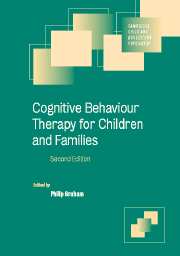Book contents
- Frontmatter
- Contents
- List of contributors
- 1 Introduction
- Part I Developmental cognitive theory and clinical practice
- Part II Engagement and assessment
- 5 Engagement and motivational interviewing
- 6 Cognitive case formulation
- Part III Client groups
- Part IV Applications in psychosocial adversity
- Part V Applications in specific child and adolescent psychiatric disorders
- Part VI CBT applications in preventive interventions
- Index
- References
5 - Engagement and motivational interviewing
Published online by Cambridge University Press: 21 August 2009
- Frontmatter
- Contents
- List of contributors
- 1 Introduction
- Part I Developmental cognitive theory and clinical practice
- Part II Engagement and assessment
- 5 Engagement and motivational interviewing
- 6 Cognitive case formulation
- Part III Client groups
- Part IV Applications in psychosocial adversity
- Part V Applications in specific child and adolescent psychiatric disorders
- Part VI CBT applications in preventive interventions
- Index
- References
Summary
Introduction
In psychiatric and psychological practice, it is often assumed that when people present for an assessment the mere act of attendance suggests that the person has decided that he or she wants ‘something’, either a diagnosis or treatment. This also implies that the patient recognizes that something is wrong, that something distresses them and that they want to change or overcome their ‘problem’. A further assumption is that it is the job of the health care practitioner to give information, advice or practical help, so as to induce positive change, improvement in health and reduce distress in their patient.
To a degree, these tacit assumptions have validity but often when working with young people, while their parents may fully subscribe to the above assumptions, there may be gross disparities between the goals of the parents and health practitioner on the one hand and those of the young person on the other. Some of these disparities result from developmental issues; others result from aspects of the disorder/problem itself that the young person presents with.
For example, one of the important developmental tasks of adolescence is for the young person to develop an individual identity and to become independent from their family of origin. To do and think things that go against adult authority and rules is a normal part of growing up.
- Type
- Chapter
- Information
- Cognitive Behaviour Therapy for Children and Families , pp. 67 - 83Publisher: Cambridge University PressPrint publication year: 2004



